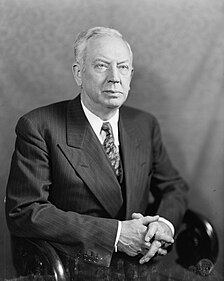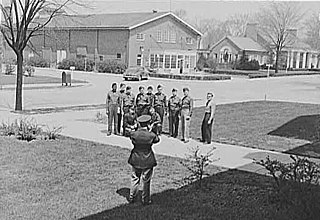
The 38th Infantry Division ("Cyclone") is one of the eighteen divisions of the United States Army, and one of eight National Guard divisions. It is headquartered in Indianapolis, Indiana, and contains Army National Guard units from Indiana, Ohio, Kentucky, Delaware, Michigan, Tennessee and Other States.

Milton Atchison Reckord was a lieutenant general in the National Guard of the United States. He also served as Adjutant General of the State of Maryland.

Edward "Ed" Martin was an American lawyer and Republican party politician from Waynesburg, Pennsylvania. He served as the 32nd Governor of Pennsylvania from 1943 until 1947 and as a United States Senator from Pennsylvania from 1947 until 1959.

The Indiana National Guard is the armed force of the state of Indiana. It consists of the Indiana Army National Guard and the Indiana Air National Guard, and is part of the larger Army National Guard and the Air National Guard. With roots dating back to 1801, Indiana units first served in a national conflict in 1846 during the Mexican–American War, and were reorganized into their current configuration in 1903. Since then the guard has served at home and abroad as a part of multiple wars, disaster relief actions, and putting down strikes and riots.

Robert Henry Tyndall was a United States artillery officer in World War I, a major general, and mayor of Indianapolis during World War II.

Fort Benjamin Harrison was a U.S. Army post located in suburban Lawrence Township, Marion County, Indiana, northeast of Indianapolis, between 1906 and 1991. It is named for the 23rd United States president, Benjamin Harrison.

Heslar Naval Armory was constructed in 1936 in Indianapolis, Indiana, United States, on the shore of White River as a Works Progress Administration construction project. It was designed by architect Ben H. Bacon and reflects an Art Moderne style. Heslar Naval Armory was the home of Naval Operations Support Center Indianapolis, Marine Corps Reserve Center Indianapolis, and Naval Recruiting Station Indianapolis, as well as the United States Naval Sea Cadet Corps Cruiser Indianapolis (CA-35) Division and the Central Indiana Young Marines of the Marine Corps League. In October 2008 the Indiana Wing Civil Air Patrol, state branch of the US Air Force Auxiliary, moved its headquarters functions and staff to the Armory.

Indiana, a state in the Midwest, played an important role in supporting the Union during the American Civil War. Despite anti-war activity within the state, and southern Indiana's ancestral ties to the South, Indiana was a strong supporter of the Union. Indiana contributed approximately 210,000 Union soldiers, sailors, and marines. Indiana's soldiers served in 308 military engagements during the war; the majority of them in the western theater, between the Mississippi River and the Appalachian Mountains. Indiana's war-related deaths reached 25,028. Its state government provided funds to purchase equipment, food, and supplies for troops in the field. Indiana, an agriculturally rich state containing the fifth-highest population in the Union, was critical to the North's success due to its geographical location, large population, and agricultural production. Indiana residents, also known as Hoosiers, supplied the Union with manpower for the war effort, a railroad network and access to the Ohio River and the Great Lakes, and agricultural products such as grain and livestock. The state experienced two minor raids by Confederate forces, and one major raid in 1863, which caused a brief panic in southern portions of the state and its capital city, Indianapolis.
During the American Civil War, Indianapolis, the state capital of Indiana, was a major base of supplies for the Union. Governor Oliver P. Morton, a major supporter of President Abraham Lincoln, quickly made Indianapolis a gathering place to organize and train troops for the Union army. The city became a major railroad hub for troop transport to Confederate lands, and therefore had military importance. Twenty-four military camps were established in the vicinity of Indianapolis. Camp Morton, the initial mustering ground to organize and train the state's Union volunteers in 1861, was designated as a major prisoner-of-war camp for captured Confederate soldiers in 1862. In addition to military camps, a state-owned arsenal was established in the city in 1861, and a federal arsenal in 1862. A Soldiers' Home and a Ladies' Home were established in Indianapolis to house and feed Union soldiers and their families as they passed through the city. Indianapolis residents also supported the Union cause by providing soldiers with food, clothing, equipment, and supplies, despite rising prices and wartime hardships, such as food and clothing shortages. Local doctors aided the sick, some area women provided nursing care, and Indianapolis City Hospital tended to wounded soldiers. Indianapolis sent an estimated 4,000 men into military service; an estimated 700 died during the war. Indianapolis's Crown Hill National Cemetery was established as one of two national military cemeteries established in Indiana in 1866.
The 150th Field Artillery Regiment is a field artillery unit in the Indiana Army National Guard.

William Graham Everson was a major general in the United States Army who served as Chief of the National Guard Bureau.
The 149th Indiana Infantry Regiment was an infantry regiment from Indiana that served in the Union Army between March 1 and September 27, 1865, during the American Civil War.

Murdock A. Campbell was a Vermont attorney and military officer who served as Adjutant General of the Vermont National Guard.
The Adjutant General of Indiana is the commander of the Indiana National Guard, the Indiana Guard Reserve, and, when active, the Indiana Naval Militia. The Adjutant General is responsible for all state, non-federalized military and reports directly to the Governor of Indiana. Indiana's TAG is appointed by the governor and serves a term concurrent with the governor. The Adjutant General must hold a rank of Brigadier General (BG) or higher.
John Small (1759–1821) was an American gunsmith, frontiersman, soldier, and public official. An Irish immigrant to Pennsylvania, he served in the American Revolutionary War. After the war, he served as sheriff of Knox County, Indiana, as a territorial legislator, and as Indiana Territory's first Adjutant General.

Dana T. Merrill was a career officer in the United States Army. A veteran of the Spanish–American War and World War I, Merrill attained the rank of brigadier general, and was most notable as the World War I chief of staff for the 37th Division, and the commander of the 10th Infantry Regiment, three infantry brigades, and two corps areas.
Charles White Berry was an American physician, soldier, and New York City Comptroller.
Elmer W. Sherwood was an Indiana politician and state adjutant general for the Indiana National Guard in 1945.
John Milton Wallace was a judge and military officer in the state of Indiana. He served as state Adjutant General at the start of the Civil War.
Vernon E. Kniptash was an Indianapolis engineer and a corporal during World War I. He kept a diary which is published under the title On the Western Front with the Rainbow Division.











